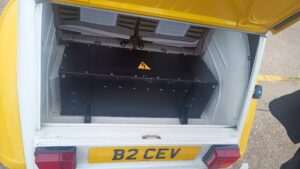It was going to happen at some point. The rise of the EV was bound to enter the classic car world. And it has been a subject of great discussion ever since. I was fortunate to taste my first classic EV conversion on the recent SMMT test day at the Millbrook proving ground in Bedfordshire.
It’s difficult to know where to start with the converted Citroën 2CV from 2CEV www.2cEv.co.uk. Apart from the yellow paint on the Dolly scheme, visually it looks no different from a standard car except for the charging plug being where the fuel filler cap would be.
The website gives a good sell and tells you all you need to know. There is a 6 month lead time.
Driving Experience
 2CV’s make a lovely sound. That chirp of the 2 pot engine is unmistakable. You can hear a 2CV from half a mile away. And it makes you smile. There is an art to 2CV driving too. Once you understand how best to spin the large heavy flywheel, you get a greater understanding of keeping forward motion.
2CV’s make a lovely sound. That chirp of the 2 pot engine is unmistakable. You can hear a 2CV from half a mile away. And it makes you smile. There is an art to 2CV driving too. Once you understand how best to spin the large heavy flywheel, you get a greater understanding of keeping forward motion.
There isn’t much involvement with the EV conversion. You don’t even need to use the clutch. This car had its clutch pedal disconnected and left in third gear. With 120 Nm of torque, that is enough to cause incredible wheel spin.
This EV conversion simplifies driving. You turn it on with the key. Press the pedal and away you go. Here is some good news. The electric motor pulls the car away in a sprightly fashion. I’d like to have had the opportunity to use the other gears. I’m sure this thing would be hilarious at the traffic light grand prix.
Good or bad, this in turn makes changing gears redundant. Flicking the umbrella gearstick protruding from the dashboard is all part of the 2CV charm. It’s easy to use and makes a lot of sense in practice. Here however it isn’t needed except for reverse.
One thing that did take me some time to become accustomed to was the steering. 2CV’s have this thing where they load up the wheel as you turn in. With the electric motor being so much lighter than the petrol engine, it loses some of that feel. The battery being placed in the boot also distributes some of the weight balance in the car. It is around 30kg heavier than a standard car overall.
You can still get tyre squeal in a corner and because the spring rates are as standard, it still manages to roll around like a normal 2CV. But merrily bobbing along is different. 2CV’s are noisy. Without the engine, 2CV’s are noisy but in a different way. You don’t realise how rattly they are without the engine up front. It became irritatingly annoying.
Problems Ahead?
One thing I didn’t quite factor in was road tax. At present EV’s are exempt. Classics up to 1983 are exempt. But classics are only exempt up to a point. Start modifying them and it becomes a grey area. There is a percentage of what has to be kept to qualify for exemption. At some point, EV’s will be taxed. And this modification must also alter the insurance costs for the car.
Changing the fundamentals like an engine alters a huge percentage of the standard car too. You could find that tax-free motoring isn’t tax-free anymore. That said, anyone spending £16,995 to convert their 2CV to electric isn’t going to be scraping around their wallet for some road tax money or the cost of an MOT!
Even though l don’t want to get involved with the costs, for your £32,500 for a complete car or £16,995 for a conversion, the battery which is a large part of an EV is only guaranteed for 3 years.
Not Sold
I’m not going to bang on about the costs. It has been said time and time again. If you can afford to have it done then you will. But ignoring the costs involved, you just aren’t involved enough with the sense of driving. And that’s the point of owning a classic. For me, it is anyway. I like the mechanical involvement of the occasion. The feeling you get through your ears that operates like an onboard diagnostic computer inputting sounds that are good and sounds that are not.
And then there is a range. Here the website doesn’t sell the idea well.
 “You might think 65 miles is not enough but…The average yearly mileage in the UK is 7134 miles which is less than 20 miles per day. (released by the Department for Transport calculated from MOT dates) and the average mileage for classic cars is way below 500 miles per year.
“You might think 65 miles is not enough but…The average yearly mileage in the UK is 7134 miles which is less than 20 miles per day. (released by the Department for Transport calculated from MOT dates) and the average mileage for classic cars is way below 500 miles per year.
This means if you only drive your classic for 6 months out of the year and only drive it on weekends it is still below 15 miles per day.
So our range of 65 miles will be plenty for most people.
65 miles just isn’t enough. The joy of having a classic car is being able to hit the road. More often than not I can take one of the Birdy Fleet of Broken Dreams oldies and be gone for hours. Doing over 100 miles for the sheer hell of it is not uncommon.
If this was mine and I wanted to see friends, I’d be best to leave my 2CEV at home. There are very few destinations that I can get to on one charge. Let alone coming home again.
With their long lead time, some feel this is a worthy conversion. And good luck to them. I’m still not convinced. There are too many limitations for this to work for me. the main one being the paltry range. I remember the eye rolls at the “a lot of money for no range” Honda E launch One Of The Family Now for the same money, you can now buy a 2021 Honda E with 100 miles of range and more driver comforts. Suddenly secondhand EV’s make sense.
I’m not against those having a classic converted to an EV. I like the engineering involved with anything mechanical. But it needs to be better than it currently is to get my vote. As with many conversions I have seen at shows, I have my own reservations. Just don’t come telling me that it is better. Converting a classic (at present at least) isn’t better.

